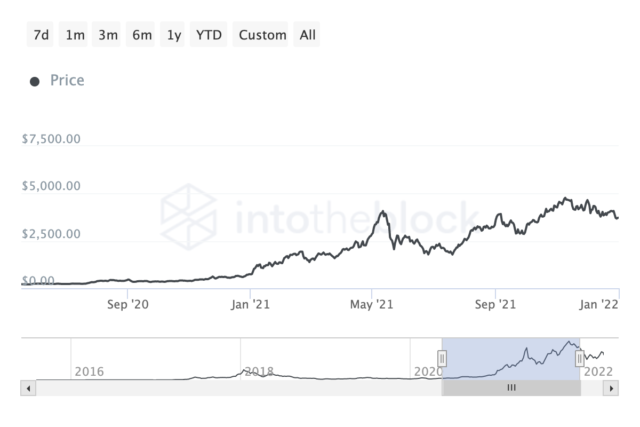Throughout history, traditional stock investors have had some tried-and-true measures to assess the risk and opportunity of a particular asset. Things like Earnings per Share (EPS), Price to Earnings Ratio (P/E Ratio), EBITDA, macroeconomic conditions—all are markers for both risk and opportunity. But what about crypto investments?
Until recently, the waters here have been far murkier.
In cryptocurrency’s early days, investors had coins they could choose to purchase, with the hopes those coins would increase in value. To assess the risk/opportunity, the best metric available was the market cap of the coin; that is, the circulating supply multiplied by the price per coin. Risk was high, but in many cases, so were returns (and losses).
Today, decentralized finance (DeFi) investment opportunities are expanding. In many cases, DeFi investment vehicles mirror options in traditional finance (TradFi) itself, such as lending, borrowing, and structures similar to mutual funds. There are healthy returns to be made, and often, the returns can outpace TradFi assets—but certainly not always, so diligent assessment is important.
How does someone begin to think about these opportunities? Liquidity in a DeFi, or web3, protocol is a critical factor when assessing the longer-term viability of these new financial instruments. To understand why, let’s take a quick tour through the rise of crypto as an investment vehicle, using TradFi analogies along the way, and then evaluate how an investor can measure today’s crypto assets.
Crypto Risk’s Tremulous Beginnings
When reviewing equity investments, there are many indicators that can be analyzed, such as those mentioned above. Before DeFi’s gradual maturation, metrics analogous to TradFi’s EBITDA, P/E Ratio, and the like were absent, and only the coin’s market cap could be used—adding to a lack of trust for the risk-averse investor. Still, many could see the wild gains earned by the early adopters, and even without the comfort of metrics, were ready to wade in.
It could be argued that one reason the Initial Coin Offering (ICO) craze of 2017-2018 ended with so many failures is that there was not a good way to gauge the success of a project. As it happened, many of the ICO projects failed to deliver.
When the ICO craze ended, the “crypto-winter” began as these early investors grew wary. Ethereum fell from its high of $1,448 in January, 2018 to a low of less than $100 in December 2018. Bitcoin hit a high over $17,000 in December 2017 and dropped below $4,000 a year later in December 2018.
A New Growth Season Begins
Enter Uniswap, a decentralized automated market maker (AMM), which is a vehicle to trade assets without a centralized order book. The advent of AMMs in 2020 meant that fees paid by traders would be shared among anyone providing liquidity into the system. This proved to be a highly effective way of “bootstrapping” liquidity for newly listed assets and the web3 projects they fuel.
Crypto prices began to rise again, and “Crypto Summer” had begun. Crypto projects started to provide utility to the world. Until this point, crypto had largely been a store of value investment.
Much as summer spurs the growing season, we suddenly saw a plethora of financial instruments being developed, deployed on the blockchain, and actively used. Money (in the form of crypto) started to pour into these financial instruments.
The chart below shows the correlation between Uniswap liquidity and the price of Ethereum—the blockchain on which Uniswap operates and where the majority of DeFi vehicles exist.

Uniswap Liquidity via IntoTheBlock’s Uniswap protocol insights
Price of Ethereum via IntoTheBlock’s pricing insights
New Measures for Crypto Investors
All early innovative technologies go through an evolutionary arc, and crypto is no exception. With the advent of AMMs and increasingly diverse investment options, there are now more measurable markers of success for DeFi projects. And since all protocols are on a publicly accessible blockchain, anyone has access to these metrics. This inherent transparency is a notable contrast to TradFi, where opaque financial arrangements can introduce hidden risks—as was vividly seen during the subprime mortgage crisis in 2008-2009.
Possibly the most important measure of a protocol’s success and future stability is liquidity in the protocol.
Here, liquidity refers to how much value is deposited into the protocol. The latest version of Uniswap has over $4.5B deposited into it. That means market participants have put $4.5B into its liquidity pools in an effort to profit from their share of trading fees.
Liquidity is important because the more liquidity that is present, the more the protocol can be used without negative consequences. If liquidity gets too low, a protocol becomes inefficient. For example, for AMM protocols, there may not be enough supply to meet demand, or there may be a large gap between the buyers’ and sellers’ price point. If liquidity goes to zero, it stops working completely.
Here is an example of some well-known protocols and the total liquidity in each (as reported by the protocol on April 12, 2022):
| Uniswap v3 | $4.8B |
| Uniswap v2 | $3B |
| Rari | $884M |
| Tokemak | $1.3B |
For AMMs, generally there are two types of liquidity to look at. First is the total liquidity in the entire protocol. Additionally, there is liquidity of each particular “pool.” When choosing where to invest, you must choose which pool in the protocol to deploy capital. Continuing with our Uniswap example, there are thousands of assets that can be traded. To facilitate that, each asset must be in at least one liquidity pool. Therefore there are thousands of pools to choose from.
The measure of liquidity in each pool is another key consideration. If there is not enough liquidity in a given pool, it will be inefficient or useless. It won’t attract users, and therefore will not earn fees. Due to the nature of each protocol and how the pools work, you may wind up losing some or all of your initial contribution to the pool.
Here is the above table, expanded to include some metrics on individual pools in the above protocols.
| Uniswap v2
● ETH/USDC Pool ● FLX/USDC ● ETH/FOX |
$3B
$277M $4M $26M |
| Rari
● Fuse Pool 7 ● Fuse Pool 79 |
$884M
$52M $7M |
| Tokemak
● Toke Sushi LP ● FOX ● SNX |
$1.3B
$117M $36M $8M |
Liquidity is important not just from an investor perspective, but also from the perspective of the various web3 protocols and for the success of web3 itself.
You can think of a web3 project’s liquidity as analogous to web2’s bandwidth. In web2, we move data across bandwidth; in web3, we move value across liquidity.
The individual investor can begin to understand this and make smarter DeFi investment decisions by studying how a target web3 project uses liquidity, assessing the current liquidity available, and looking at the trend of liquidity growth. Then, they can determine if those measures and the promoted returns warrant the risks of investing in the given protocol.
Disclaimer: The contents of this article are not to be construed as investment advice. Investing in any vehicle can carry risks; consult with an investment advisor to understand risks of specific investment opportunities.

Josh Forman
Josh Forman is an advisor to Decentralized Autonomous Organizations (DAOs) and serves on the Treasury Management Committee of ShapeShift DAO, a web3 platform where users can interface with multiple DeFi protocols across multiple chains with multiple wallets. ShapeShift DAO’s Treasury Management committee allocates over $20M in crypto assets across various DeFi protocols. Previously, Josh was the Director of Engineering at ShapeShift, Inc.; prior to that, he was an engineering leader at multiple technology startups.
Josh Forman
Josh Forman is an advisor to Decentralized Autonomous Organizations (DAOs) and serves on the Treasury Management Committee of ShapeShift DAO, a web3 platform where users can interface with multiple DeFi protocols across multiple chains with multiple wallets. ShapeShift DAO’s Treasury Management committee allocates over $20M in crypto assets across various DeFi protocols. Previously, Josh was the Director of Engineering at ShapeShift, Inc.; prior to that, he was an engineering leader at multiple technology startups.



